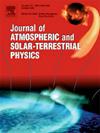Analysis of laser beam propagation through atmospheric turbulence and its impact on CCD sensor intensity distribution
IF 1.9
4区 地球科学
Q3 GEOCHEMISTRY & GEOPHYSICS
Journal of Atmospheric and Solar-Terrestrial Physics
Pub Date : 2025-05-03
DOI:10.1016/j.jastp.2025.106527
引用次数: 0
Abstract
This study investigates the propagation of laser beams with Gaussian and Laguerre-Gaussian profiles through atmospheric turbulence and their subsequent detection by charge-coupled device (CCD) sensors. Using numerical simulations based on the Kolmogorov turbulence model, we analyze the intensity distribution of laser beams under turbulence strengths ranging from 10−16 to 10−12 and propagation distances of 500 m to 5 km. The effects of atmospheric turbulence on photon distribution at the CCD sensor's pixels are quantified, revealing beam broadening with Full Width at Half Maximum (FWHM) increasing from 50 μm to 1.5 m under the highest turbulence conditions. Saturation and blooming phenomena are observed, with photon density exceeding 106 photons/pixel in high-intensity regions. Our findings reveal that turbulence-induced distortions significantly impact beam intensity profiles, with higher turbulence levels causing up to a 70 % reduction in central intensity. Additionally, the study highlights the sensitivity of higher-order Laguerre-Gaussian modes, which exhibit up to 90 % greater broadening compared to fundamental Gaussian modes. By evaluating the impact of aperture size and f-number on beam focusing, we show that increasing the f-number from 2 to 8 reduces saturation artifacts by 60 % while spreading intensity over a larger area.
激光束在大气湍流中的传输及其对CCD传感器强度分布的影响分析
本文研究了高斯型和拉盖尔-高斯型激光束在大气湍流中的传播,以及随后电荷耦合器件(CCD)传感器对其的探测。利用基于Kolmogorov湍流模型的数值模拟,分析了在湍流强度为10−16 ~ 10−12、传输距离为500 m ~ 5 km时激光束的强度分布。研究了大气湍流对CCD传感器像素处光子分布的影响,结果表明,在最高湍流条件下,光束宽度从50 μm增加到1.5 m。在高强度区域观测到饱和和开花现象,光子密度超过106光子/像素。我们的研究结果表明,湍流引起的扭曲显著影响光束强度分布,较高的湍流水平导致中心强度降低高达70%。此外,该研究强调了高阶拉盖尔-高斯模式的灵敏度,与基本高斯模式相比,高阶拉盖尔-高斯模式的展宽提高了90%。通过评估孔径大小和f值对光束聚焦的影响,我们发现将f值从2增加到8可以减少60%的饱和伪影,同时在更大的区域上传播强度。
本文章由计算机程序翻译,如有差异,请以英文原文为准。
求助全文
约1分钟内获得全文
求助全文
来源期刊

Journal of Atmospheric and Solar-Terrestrial Physics
地学-地球化学与地球物理
CiteScore
4.10
自引率
5.30%
发文量
95
审稿时长
6 months
期刊介绍:
The Journal of Atmospheric and Solar-Terrestrial Physics (JASTP) is an international journal concerned with the inter-disciplinary science of the Earth''s atmospheric and space environment, especially the highly varied and highly variable physical phenomena that occur in this natural laboratory and the processes that couple them.
The journal covers the physical processes operating in the troposphere, stratosphere, mesosphere, thermosphere, ionosphere, magnetosphere, the Sun, interplanetary medium, and heliosphere. Phenomena occurring in other "spheres", solar influences on climate, and supporting laboratory measurements are also considered. The journal deals especially with the coupling between the different regions.
Solar flares, coronal mass ejections, and other energetic events on the Sun create interesting and important perturbations in the near-Earth space environment. The physics of such "space weather" is central to the Journal of Atmospheric and Solar-Terrestrial Physics and the journal welcomes papers that lead in the direction of a predictive understanding of the coupled system. Regarding the upper atmosphere, the subjects of aeronomy, geomagnetism and geoelectricity, auroral phenomena, radio wave propagation, and plasma instabilities, are examples within the broad field of solar-terrestrial physics which emphasise the energy exchange between the solar wind, the magnetospheric and ionospheric plasmas, and the neutral gas. In the lower atmosphere, topics covered range from mesoscale to global scale dynamics, to atmospheric electricity, lightning and its effects, and to anthropogenic changes.
 求助内容:
求助内容: 应助结果提醒方式:
应助结果提醒方式:


